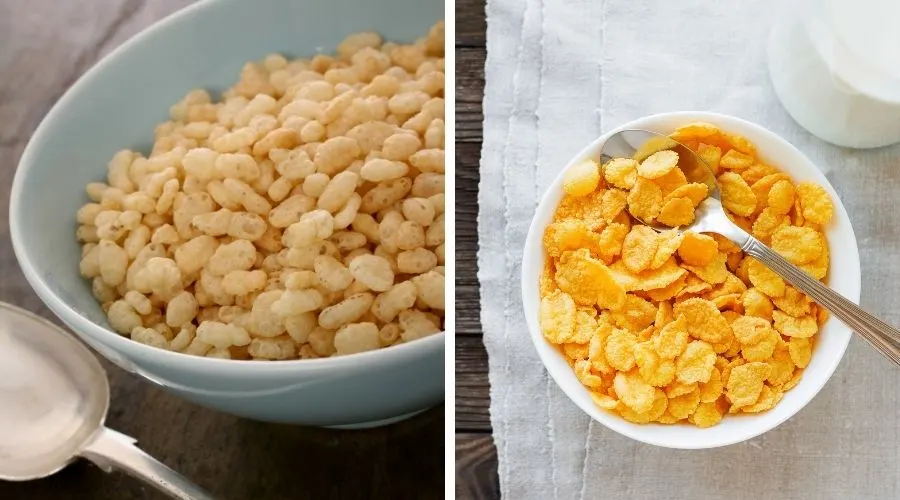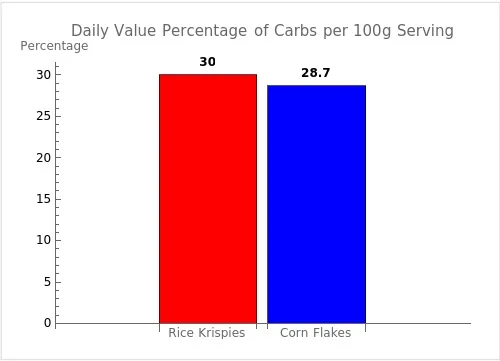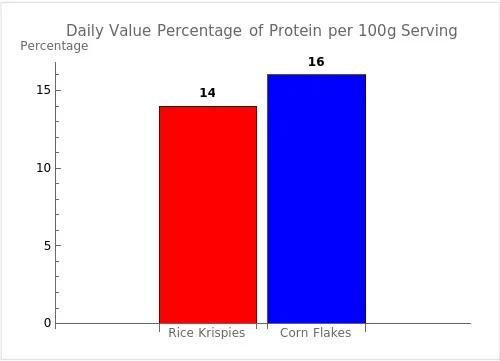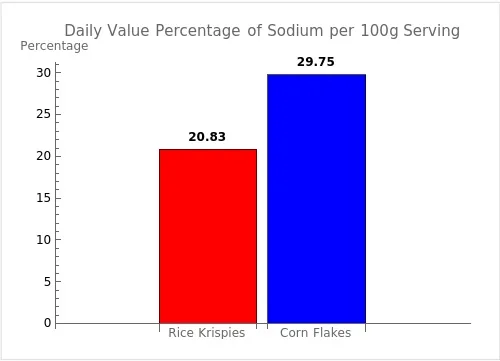Rice Krispies and Corn Flakes are iconic breakfast cereals that have been around for decades, but are they any good for us when it comes to nutrition, and which is the best of the two?
In this article, I’ll be comparing Kellogg’s Rice Krispies against Kellogg’s Corn Flakes to find out which is best in each nutritional category, what they’re made from, and which brand gives you the most cereal for your money.
Read on to find out which cereal wins and take part in our poll to tell us which is your favorite when it comes to flavor and texture.
Also in This Article
In a hurry, or looking for something specific? Use the links below to jump to the relevant section:
- Ingredients Comparison
- Rice Krispies Vs. Corn Flakes Nutritional Comparison:
- Best for Calorie Content
- Best for Carbs & Sugar Content
- Best for Protein Content
- Best for Fat Content
- Best for Fiber Content
- Best for Sodium/Salt Content
- Best for Vitamins/Minerals
- Best for Flavor/Texture
- Best for Price
- Overall Winner
Ingredients Comparision
Let’s start by comparing the ingredients of the two cereals. As you can see from the table below, the key difference is the main ingredients which might not come as a surprise!
The main ingredient of Rice Krispies is rice, compared to Corn Flakes, which is milled corn. Apart from that, the cereals both contain identical additional ingredients, including sugar, salt, and malt flavor.
They also contain added vitamins and minerals to help consumers get closer to their daily recommended values of various nutrients.
| Rice Krispies Ingredients | Corn Flakes Ingredients |
Rice, sugar, contains 2% or less of salt, malt flavor. Vitamins and minerals: iron (ferric phosphate), niacinamide, vitamin b6 (pyridoxine hydrochloride), vitamin b2 (riboflavin), vitamin b1 (thiamin hydrochloride), folic acid, vitamin d3, vitamin b12. | Milled corn, sugar, malt flavor, contains 2% or less of salt. Vitamins and minerals: iron (ferric phosphate), niacinamide, vitamin b6 (pyridoxine hydrochloride), vitamin b2 (riboflavin), vitamin b1 (thiamin hydrochloride), folic acid, vitamin d3. Vitamin b12. |

Rice Krispies Vs. Corn Flakes Nutritional Comparison
Rice Krispies each have different recommended serving sizes, so to ensure the comparison is accurate, I’ll be comparing them per 100g, although I’ll also include the serving data for information.
Best for Calorie Content
When it comes to calorie content, both kinds of cereal contain 150kcal per serving, although weight-for-weight Corn Flakes are slightly lower in calories compared to Rice Krispies.
| Cereal Type | Calories Per 100g | Calories Per Serving |
| Kellogg’s Rice Krispies | 375kcal | 150kcal (per 40g serving) |
| Kellogg’s Corn Flakes | 357kcal | 150kcal (per 42g serving) |
Carbohydrate Content
I’ve included carbohydrates for information but not in the overall comparison because neither cereal can be considered a low-carb breakfast option.
So for information, the cereal that is lowest in carbs is Corn Flakes, which contains just 4g fewer carbs per 100g compared to Rice Krispies.
| Cereal Type | Carbohydrates Per 100g | Carbohydrates Per Serving |
| Kellogg’s Rice Krispies | 90g | 36g (per 40g serving) |
| Kellogg’s Corn Flakes | 86g | 36g (per 42g serving) |

- Rice Krispies provide 30% of the daily value for carbohydrates.
- Corn Flakes provide 28.7% of the daily value for carbohydrates.
The recommended daily intake of carbohydrates on a 2,000 calorie diet is about 300 grams. The values on the graph represent the percentage of the daily value that each 100g serving of the cereals provides.
Best for Sugar Content
Neither Rice Krispies nor Corn Flakes is particularly high in sugar compared to some breakfast cereals. Both contain 4g of sugar per serving, which is just under a teaspoon, and 8% of the recommended daily intake.
Weight-for-weight Rice Krispies have 0.5g more sugar per 100g; however, this is a nominal amount.
| Cereal Type | Sugars Per 100g | Sugars Per Serving |
| Kellogg’s Rice Krispies | 10g | 4g (per 40g serving) |
| Kellogg’s Corn Flakes | 9.5g | 4g (per 42g serving) |
Best for Protein Content
When it comes to protein content, neither cereal is particularly high in protein. Both contain 3g of protein per serving, with Rice crispies containing 0.4g more per 100g, which again is a nominal difference.
| Cereal Type | Protein Per 100g | Protein Per Serving |
| Kellogg’s Rice Krispies | 7.5g | 3g (per 40g serving) |
| Kellogg’s Corn Flakes | 7.1g | 3g (per 42g serving) |

The recommended daily intake of protein is generally 50 grams for the average adult on a 2,000 calorie diet. The graph shows that Rice Krispies provide 14% and Corn Flakes provide 16% of the daily value for protein per 100g serving.
Best for Fat Content
Neither Rice Krispies nor Corn Flakes contain any fat, saturated fat, or cholesterol, making them joint winners if fat content is a consideration for your diet.
| Cereal Type | Fat Per Serving | Saturated Fat per Serving |
| Kellogg’s Rice Krispies (per 40g serving) | 0g | 0g |
| Kellogg’s Corn Flakes (per 42g serving) | 0g | 0g |
Best for Fiber Content
When it comes to dietary fiber, Corn Flakes contain 1g of fiber per serving, whereas Rice Krispies don’t contain any.
While Corn Flakes is the winner of the two, they’re also very low in fiber compared to whole-grain wheat or bran-based cereals.
| Cereal Type | Dietary Fibre Per 100g | Dietary Fibre per Serving |
| Kellogg’s Rice Krispies | 0g | 0g (per 40g serving) |
| Kellogg’s Corn Flakes | 2.4g | 1g (per 42g serving) |
Best for Sodium/Salt Content
Both kinds of cereal contain added salt, but the cereal with the highest sodium levels is Corn Flakes, with 214mg more sodium per 100g.
To put this into the context of a recommended daily value, Rice Krispies contain 9%, whereas Corn Flakes contain 13%.
| Cereal Type | Sodium/Salt Per 100g | Sodium/Salt per Serving |
| Kellogg’s Rice Krispies | 500mg | 200mg (per 40g serving) |
| Kellogg’s Corn Flakes | 714mg | 300mg (per 42g serving) |

The graph indicates that Rice Krispies provide 20.83% and Corn Flakes provide 29.75% of the daily value for sodium per 100g serving, based on a 2,000 calorie diet.
Best for Vitamins/Minerals
Kellogg’s fortify Rice Krispies and Corn Flakes with the same vitamins and minerals and the same amounts.
The table below shows which vitamins and minerals are added to both kinds of cereal and the daily value percentages per serving.
| Vitamin/Mineral Type | Rice Krispies Daily Value % | Corn Flakes Daily Value % |
| Vitamin D | 15% | 15% |
| Iron | 60% | 60% |
| Thiamin | 30% | 30% |
| Riboflavin | 30% | 30% |
| Vitamin B6 | 30% | 30% |
| Vitamin B12 | 30% | 30% |
| Niacin | 30% | 30% |
| Folic Acid | 50% | 50% |
Best for Flavor/Texture
When it comes to choosing the best cereal for flavor and texture, this isn’t an easy category to judge without a wide opinion over a broad demographic of voters.
Please help us out by voting for your favorite (Rice Krispies or Corn Flakes), and once you vote, the winner so far will be revealed.
Best for Price
Below are the current average prices of each cereal for the two main pack sizes; based on this information, the average cost per ounce is the same, making Kellogg’s Rice Krispies and Corn Flakes joint winners for price.
- Kellogg’s Rice Krispies 18oz box = $3.28 / 18.2¢ per ounce
- Kellogg’s Rice Krispies 25.2oz box = $5.25 / 20.9¢ per ounce
- Kellogg’s Corn Flakes 18oz box = $3.28 / 18.2¢ per ounce
- Kellogg’s Corn Flakes 25.2oz box = $5.23 / 20.9¢ per ounce
Please note that prices are based on averages and may fluctuate over time, depending on the store where you buy them and promotional offers.
Overall Winner
This was a really close contest all the way through, with little difference between the two kinds of cereal nutritionally, but of the two, the cereal which came top in most categories is – Corn Flakes.
Corn Flakes contain slightly fewer calories, are slightly higher in protein, and contain 1g of fiber, whereas Rice Krispies don’t contain any.
In contrast, Rice Krispies are slightly lower in sugar and sodium, and like Corn Flakes, they don’t contain any fat.
So it all comes down to which one you like best because there’s little difference between the two, but hopefully, the data in this article can help you decide which is best for your needs.
| Comparison Category | Winner (Rice Krispies or Corn Flakes) |
| Best for Calorie Content | Corn Flakes |
| Best for Sugar Content | Rice Krispies |
| Best for Protein Content | Corn Flakes |
| Best for Fat Content | Joint Winners |
| Best for Fiber Content | Corn Flakes |
| Best for Sodium Content | Rice Krispies |
| Best for Vitamins/Minerals | Joint Winners |
| Best for Price | Joint Winners |
| Overall Winner | Corn Flakes |
Related Articles
I hope this article has helped you to find the information you were looking for; you might also find the following articles helpful too:
Rice Krispies Vs. Cheerios (Which is Best?)
Lucky Charms Vs. Cheerios (Which is Best?)
Multi Grain Cheerios Vs. Regular Cheerios
References Used for this Article
To ensure the nutritional information used in this article is accurate, I have used data from the manufacturer; the links below contain the source information:
